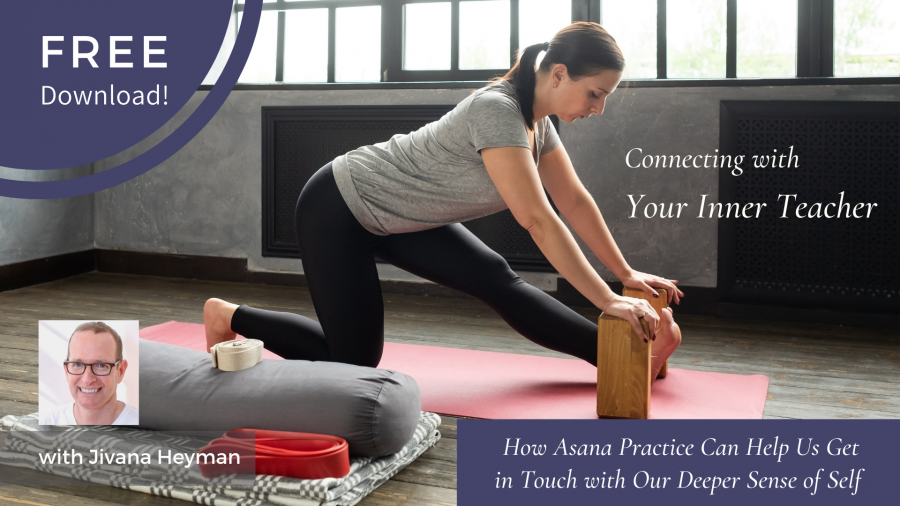Free Download! Connecting with Your Inner Teacher: How Asana Practice Can Help Us Get in Touch with Our Deeper Sense of Self
Course Info
- Price:
- $0.00
Jivana Heyman
 Jivana Heyman, C-IAYT, E-RYT500, is the founder and director of Accessible Yoga, an international non-profit organization dedicated to increasing access to the yoga teachings. He’s the author of the book, Accessible Yoga: Poses and Practices for Every Body (Shambhala Publications 2019), co-owner of...
Jivana Heyman, C-IAYT, E-RYT500, is the founder and director of Accessible Yoga, an international non-profit organization dedicated to increasing access to the yoga teachings. He’s the author of the book, Accessible Yoga: Poses and Practices for Every Body (Shambhala Publications 2019), co-owner of... 
The key to building a powerful yoga practice? Stop honing in on the shapes of asana poses, and focus instead on cultivating a greater awareness of the subtle changes happening in your body as you practice.
So says Jivana Heyman, yoga teacher, certified yoga therapist, and author of Accessible Yoga: Poses and Practices for Every Body in this free download interview.
In his work as founder of Accessible Yoga, Jivana has fashioned yoga practices to suit every body, regardless of limitations. But he points out that there is much more to expanding access to yoga than simply adapting asana poses.
“The fundamental purpose of yoga is to understand the nature of the mind and the relationship of the mind and body,” he explains. “It’s to connect with an inner sense of self that we can call spirit. An external teacher can’t do that for you. That’s really a process of finding your own inner teacher.”
Using the yogic principle of self-study, called Svadyaya, we can cultivate a greater sense of what’s going on inside, says Jivana. He explains how when teachers help their students to find a deeper way into practice, it’s an act of empowerment.
“You want students to ask themselves, ‘What am I feeling here and why?’ This is how teachers can honor the traditional teachings of yoga,” he explains.
The spiritual practice of yoga is accessible to anyone willing to tap into the subtle awarenesses that can arise and is not based on physical prowess. “I love asana but I sometimes think that the image of yoga as an extreme asana practice does a disservice because it makes people think that yoga’s not for them. But really anyone who wants it can practice yoga,” he says.
One of his goals as a teacher is to eventually have his students become independent enough to develop their own practices away from a class setting. And to focus not purely on the physical, but on the mental aspect as well.
“I sometimes have people just imagine the poses in their mind and it’s an amazing experience because it’s not just a physical practice. It’s about the relationship you have between body and mind and how that relationship connects us with a deeper sense of ourselves. This is true regardless of what condition the body is in. Your ‘yoginess’ is not taken away when you lose the physical ability to do poses,” Jivana states.
That inner sensation of interoception is a primary key to practice. Rather than working to acquire more and more extreme poses, Jivana says that learning to notice and feel what’s happening in the body and increase our subtle awareness of it is the real mark of an advanced practice.
“It’s not just a process of increasing sensation. It’s also about learning how to use your mind,” he explains. “I want students to ask ‘Where is my mind going when I am practicing?’ I always think it’s amazing to witness how we can move energy with the mind. When we bring awareness to the right big toe, for example, there’s suddenly more energy there.”
A key aspect of Jivana’s work is rooted in his background as an HIV-Aids activist in the 80s. An effort to bring yoga to the HIV-Aids community led him to develop teacher trainings for the greater disability community as a form of self-empowerment. For him, that passion about equity and justice translates easily to the core of yoga.
“The teachings of yoga rest on this idea of equity and justice, truthfulness and non-harm. At the core, yoga is an ethical practice.”
Jivana believes that networking and community building – bringing together people in specific areas of interest, such as the low-vision community, or working with autism, for example – is another practice that embodies yoga in the true sense. In this he’s buoyed by the recent efforts to diversify the yoga community to bring in more voices.
The approach to movement in practice – the focus, the breath, bringing awareness to it and seeing what you are avoiding, or sensing, and staying with discomfort as a process of discovery – is what differs asana practice from purely physical exercise. And that process of self-discovery can net greater wisdom when we are open to whatever we discover in our practice, even if what is revealed are unresolved feelings of fear, grief, or other discomfort, Jivana explains.
“The body is like an archaeological dig and asana is our shovel. It’s the tool we use to dig down into the layers that are hidden to reveal what the truth is for us.”